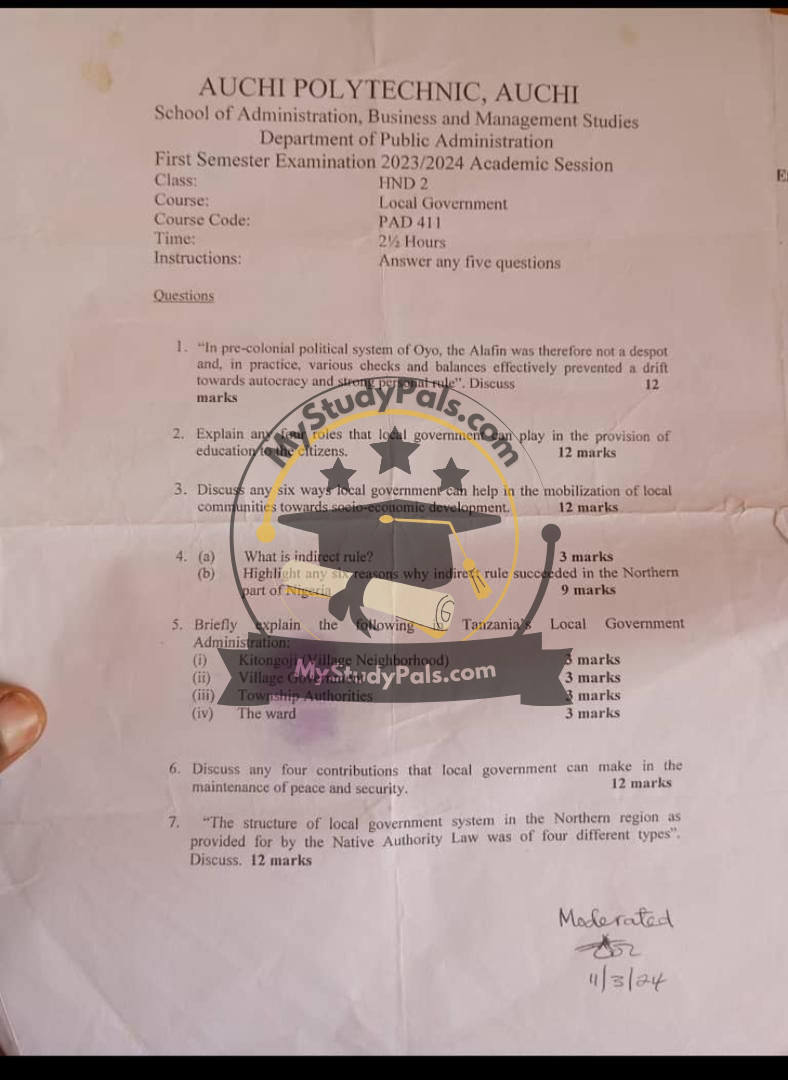ANWSER
—
Question 1:
Answer:
In the pre-colonial political system of Oyo, the Alafin (king) was not an absolute ruler due to the existence of checks and balances that prevented autocracy. Key mechanisms included:
– The Oyomesi (council of chiefs) who advised the Alafin and could reject his decisions.
– The Ogboni society, which served as a religious and political body to ensure accountability.
– The Basorun, the head of the Oyomesi, who could compel the Alafin to commit suicide if he ruled unjustly.
– The Are-Ona-Kakanfo (military leader), who provided a counterbalance to the Alafin’s power.
These structures ensured collective governance and prevented the concentration of power in the hands of the Alafin.
—
Question 2:
Answer:
Local governments play crucial roles in the provision of education, including:
1. Infrastructure Development: Building and maintaining schools, classrooms, and facilities.
2. Teacher Support: Hiring and training teachers, especially for primary and secondary education.
3. Enrollment Drives: Mobilizing communities to ensure children attend school, particularly in rural areas.
4. Scholarships and Aid: Providing financial assistance or materials to disadvantaged students.
—
Question 3:
Answer:
Local governments can mobilize communities for socio-economic development through:
1. Sensitization Programs: Educating citizens on development initiatives like agriculture or hygiene.
2. Community Projects: Involving locals in building roads, health centers, or markets.
3. Cooperatives: Supporting farmer groups or artisans with loans and training.
4. Public Meetings: Encouraging participation in decision-making.
5. Partnerships: Collaborating with NGOs or state agencies for resource allocation.
6. Skill Development: Organizing vocational training to empower youths and women.
—
Question 4:
(a) Answer:
Indirect rule was a colonial administration system where traditional rulers (e.g., chiefs) governed on behalf of the British, enforcing colonial policies while maintaining local customs.
(b) Answer:
Indirect rule succeeded in Northern Nigeria due to:
1. Centralized Authority: The Emirs’ hierarchical system mirrored British governance.
2. Islamic Law: Sharia courts simplified legal administration.
3. Loyalty of Emirs: Collaboration with colonialists ensured stability.
4. Existing Tax System: The British utilized the Hausa-Fulani tax structure.
5. Limited Western Education: Traditional institutions faced less opposition.
6. Geographic Cohesion: Homogeneous culture facilitated uniform governance.
—
Question 5:
Answer:
– (i) Kirongoji (Village Neighborhood): Smallest administrative unit fostering community participation.
– (ii) Village Government: Elected body managing local services like health and education.
– (iii) Township Authorities: Urban bodies overseeing municipal services in towns/cities.
– (iv) The Ward: Administrative division linking villages to district governments for planning.
—
Question 6:
Answer:
Local governments contribute to peace and security by:
1. Community Policing: Supporting neighborhood watch programs.
2. Conflict Resolution: Mediating disputes through traditional councils.
3. Infrastructure: Installing streetlights and improving roads to deter crime.
4. Youth Engagement: Creating jobs or recreational programs to reduce unrest.
—
Question 7:
Answer:
The Native Authority Law established four local government structures in Northern Nigeria:
1. Emirate System: Centralized rule under Emirs (e.g., Sokoto).
2. District Heads: Subdivisions governed by Hakimis.
3. Village Heads: Oversaw smaller communities.
4. Council of Advisors: Comprised elites and religious leaders to assist Emirs.
—


